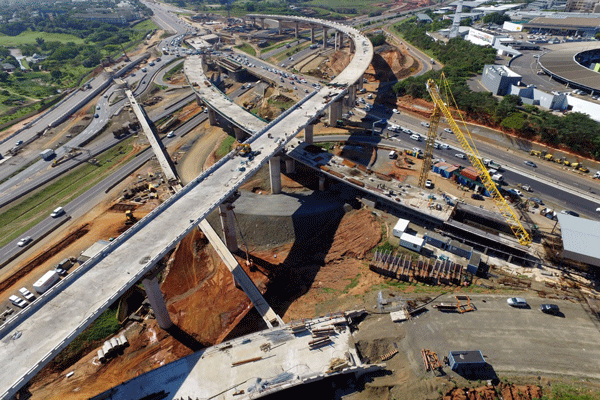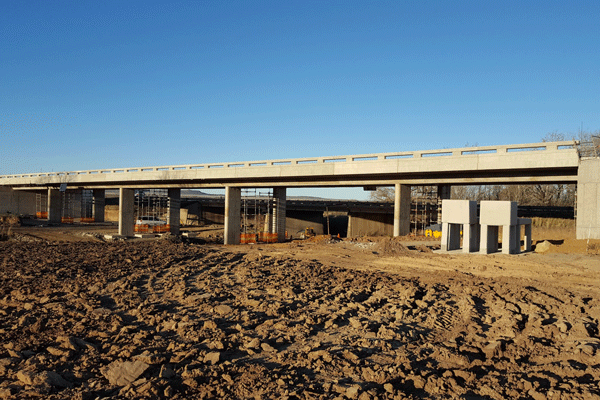
The South African National Roads Agency SOC Limited (SANRAL) Eastern Region has dispelled the old saying that “lightning never strikes the same place twice” by bagging two prestigious Fulton Awards conferred by the Concrete Society of Southern Africa.
The N2/M41 Mount Edgecombe interchange under construction at Umhlanga, north of Durban, won the Fulton Award in the main “Civil Engineering Structure greater than R100 million” category given for initiatives where totally new materials, techniques, technologies, applications, designs, and/or concepts, using concrete as the principal material, have been developed or utilised.
And if that accolade is not enough to brag about, SANRAL’s Eastern Region went on to jointly win the Fulton Award in the “Innovation in Concrete” category for the reinforced concrete Van Zyl Spruit Bridge on the N1 freeway between Trompsburg interchange and Fonteintjie in the Free State.
SANRAL Eastern Region also won a Fulton Award in the prestigious category “Civil Engineering Structure greater than R100 million” in 2015 for the uMgeni Interchange project.
Logashri Sewnarain, SANRAL Eastern Region Manager, said the two latest awards were a reflection of the high standard of work on SANRAL projects and the ability to keep up with ever-evolving economic, environmental and aesthetic demands.
“The award for Mount Edgecombe interchange is particularly significant because it shows that despite the many challenges being faced, it is still possible to produce world-class infrastructure.
“The accolades are testimony to the fact that we can hold our own in civil engineering excellence when competing in the national and international arenas and such recognition is much appreciated by everybody involved in the projects.”
The awards
The Fulton Awards began as a tribute to the late Dr Sandy Fulton for his outstanding contribution to the understanding of concrete, its development, and improvement.
Dr Fulton was unquestionably one of the more prominent figures of the international concrete industry with impressive achievements in research contained in 35 published papers. He left a legacy of scientific and technological advances in the construction industry.
The award is made symbolically to the structure and is presented to the entire team responsible for its construction, including the owner/developer, all professionals, and the contractors.
The Mount Edgecombe Interchange upgrade has changed the landscape forever and is sure to become a well-known landmark in years to come.
A concrete testament
The interchange as it stands may be considered a testament to the ability of concrete to deliver infrastructure needs on the largest scale. Constructing one of the longest structures ever built in South Africa over one of the busiest intersections in KwaZulu-Natal successfully, without ever closing any of the roads permanently, bears testimony to the success of the selected construction methods and materials.
The judges’ citation stated: “This project showcases the use of concrete in civil engineering infrastructure in that it encompasses nine new road bridges, one new pedestrian bridge, nine mechanically-stabilised earth walls and three soil nail retaining walls.
“It features three simultaneous incremental launches with a combined deck that exceeds 1.5km, the longest incrementally-launched viaduct in the southern hemisphere, and three incremental launches being constructed simultaneously.
“This is a South African first. It was conducted under difficult conditions having to maintain the requirements of the heavy existing traffic demands within a congested site.”
A first in South Africa

The Van Zyl Spruit Bridge is unique in that it is the first long integral bridge in South Africa and, at 90m, one of the longest integral bridges in the world.
The design is more complex than a conventional bridge as it involves soil-structure interaction. The five-span road bridge has a continuous deck consisting of two spline beams, fully integral with the abutments and piers, eliminating the need for bearings and expansion joints. The intermediate supports consist of pairs of reinforced concrete piers, one under each spine of the deck and the same width as the spines. The end supports are full height reinforced concrete integral abutments with integral transition slabs.
In making the award for the Van Zyl Spruit Bridge, the judges’ citation stated: “The innovative use of integral bridges allows savings in materials, no capital cost for bearings and joints, lower maintenance costs, more durability and makes concrete bridges more competitive.
“In addition, the installation of over 500 sensors in the bridge structure which are being logged automatically every 15 minutes to detect and quantify trends in strain, temperature, tilt and earth pressure, makes this one of the first ‘smart’ bridges in the country.
“The data obtained from these sensors will contribute to a better understanding of environmental loading on the performance of integral bridges in South Africa and encourage more widespread use of integral bridges.”

